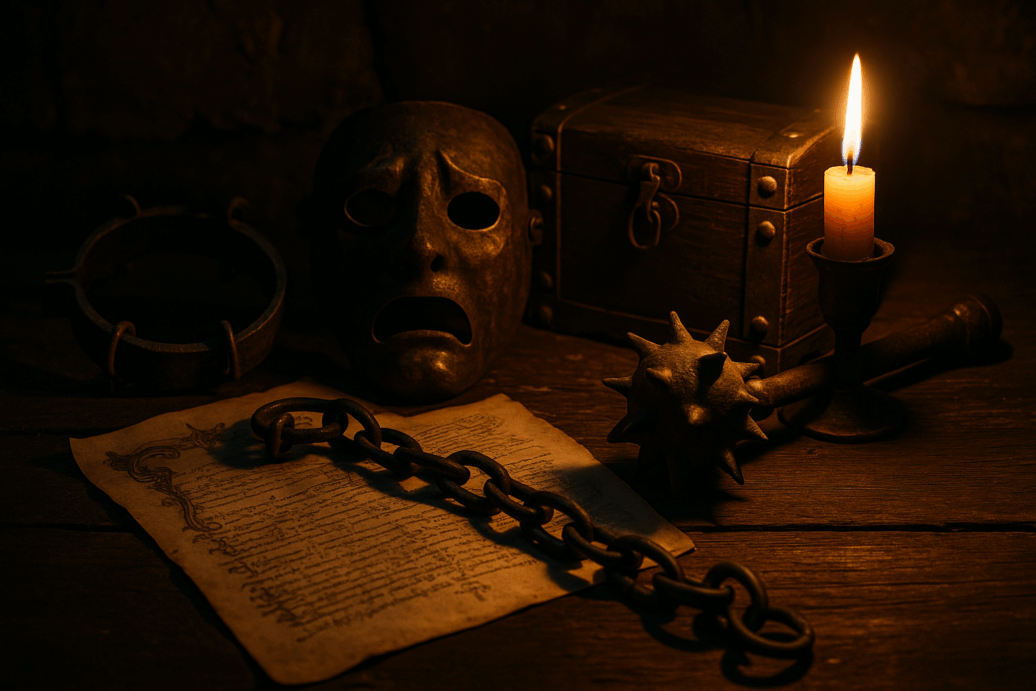Shadows in the Display Case: Why Torture Artifacts Go Missin
When we think of museum crime cases, our minds drift to golden icons or priceless paintings. Yet some of the most stolen artifacts in museums are actually rust‑eaten chains, iron maidens, and other stolen medieval torture devices. Their macabre nature, limited supply, and chilling backstories create a black‑market demand few would suspect. In this article, we follow the trail of theft, from daring heist to secret vault, uncovering why collectors risk prison for these grim souvenirs.
1. The Allure of Pain: Valuable Torture Museum Items
Unlike jewels, torture relics draw value from authenticity and rarity. Each nail or screw bears human exposure to suffering, making it irreplaceable. Private collectors—especially those fascinated by the darker edges of history—compete fiercely. A single iron gag, verified by metallurgical investigation, can fetch upward of $40,000 at clandestine auctions. Such sums fuel smuggling rings that specialize in black market medieval artifacts.
2. Famous Stolen Museum Exhibits: Vanished Overnight
One of the most famous stolen museum exhibits disappeared from a European castle in 1996: a torture chair studded with 1,500 spikes. Despite alarms, the thieves exploited a construction scaffold, removed the chair in segments, and left no clues. Similar daring occurred in 2012, when shackles used during the Spanish Inquisition vanished from a private gallery in New Orleans. These mysterious artifact disappearances often involve inside knowledge—night guards bribed, old camera systems disabled, or simple complacency.
3. How Heists Happen: From Loot to Resale
Stealing bulky iron devices seems absurd, yet seasoned criminals rely on forged documentation, or forgery, to pass pieces as replicas during transport. Once abroad, items are sold through encrypted forums. In one of the most notorious famous torture museum robberies, thieves hid thumbscrews inside a statue shipped as “garden décor.” When customs agents found the loot, they recognized the serial engraving and initiated international recovery efforts.
4. Missing Torture Artifacts and the Pursuit of Justice
Law enforcement units that track missing torture artifacts work closely with historians to establish provenance. Each rivet can leave a trace of 15th‑century smelting, helping prove or disprove legitimacy. Still, the pursuit is slow. Many pieces re‑emerge only decades later, during estate sales of deceased traffickers. The return of a Catherine Wheel fragment in 2019 ranks among the most celebrated recovered stolen torture artifacts to date.
5. Medieval Relics and Their Value: Beyond Money
Why pay six figures for an iron collar? For some, it’s the thrill of owning taboo history; for others, it’s the belief in occult power. Whatever the motive, medieval relics and their value extend beyond price tags into the psychology of possession, secrecy, and control. Each item carries a mystery of human cruelty that a painting cannot match.
6. Museum Security: Lessons Learned
Contemporary curators invest in motion sensors and blast‑proof glass, yet creative criminals adapt. After a break‑in attempt at the Medieval Torture Museum in Chicago was foiled by layered alarm zones, specialists emphasized compartmentalized display cases and RFID tagging. Meanwhile, staff at the Medieval Torture Museum in LA conduct quarterly audits, logging micro‑etchings invisible to the naked eye.
7. Dark Tourism and Demand
Oddly, publicity around thefts drives visitor interest. Travelers hunting top things to do in st augustine routinely flock to the museum’s dungeon wing, eager to see relics that “escaped” but were later found. This demand boosts revenue but also pressure: every exhibit must balance access with protection.
8. Hidden Risks: Fraud and Forgery
Where genuine stock dwindles, fraud flourishes. Fake Spanish Boots, fabricated last year, circulate online for $5,000 apiece. Experts advise verifying patina, rivet style, and archival records before any purchase. Even seasoned buyers can be duped, resulting in costly resale scandals.
9. A Collector’s Vault: Inside the Black Market
Interview snippets with anonymous dealers reveal a covert hierarchy. Artifacts pass from rural diggers to middlemen who launder paperwork, then on to elite buyers. Deals often occur in a rented hotel suite; money changes hands in cryptocurrency. Items travel wrapped in canvas to prevent new wounds or surface scratches, ensuring high appraisal.
10. Toward Ethical Curation
Modern museums advocate repatriation and transparent provenance. Through exhibitions and educational outreach, they discourage illicit trade and highlight the cultural loss when pieces vanish. The museum’s official blog publishes ongoing investigation updates, engaging readers in global artifact recovery efforts.
Final Thought
The theft of torture relics intertwines secrecy, greed, and humanity’s morbid curiosity. From clandestine heists to triumphant returns, each episode reminds us how fragile our tangible past remains. Only by valuing history over possession can we stop new chapters of loss from being written.






